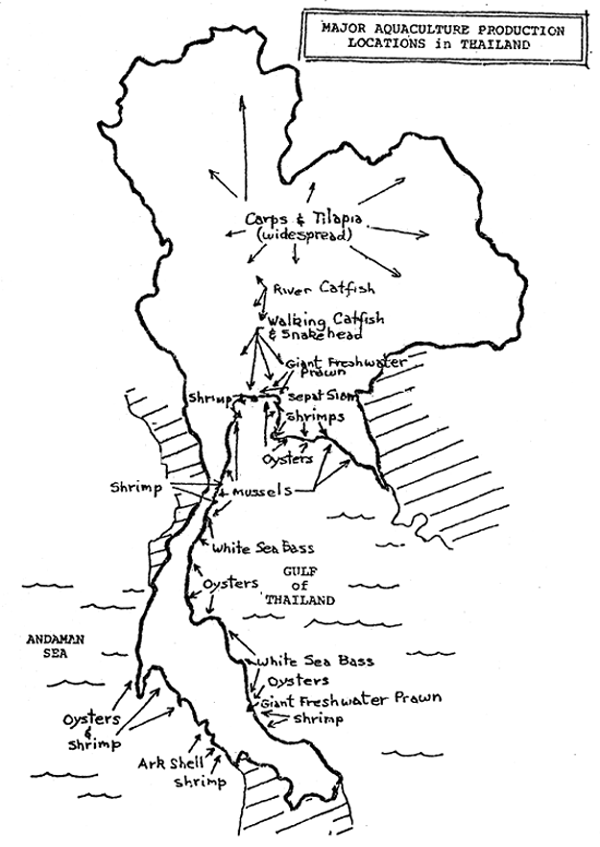
| NACA/WP/81/2 | November 1981 |
 |
Synopsis of Aquaculture in Thailand |
by
Alex Fedoruk and Thiraphan Bhukaswan
National Inland Fisheries Institute
Kasetsart University Campus
Bangkhen, Bangkok 9
NETWORK OF AQUACULTURE CENTRES IN ASIA
Bangkok, Thailand
November 1981
Hyperlinks to non-FAO Internet sites do not imply any official endorsement of or responsibility for the opinions, ideas, data or products presented at these locations, or guarantee the validity of the information provided. The sole purpose of links to non-FAO sites is to indicate further information available on related topics.
This electronic document has been scanned using optical character recognition (OCR) software. FAO declines all responsibility for any discrepancies that may exist between the present document and its original printed version.
Alex Fedoruk1 and Thiraphan Bhukaswan2
Farming aquatic animals occurs in both the inland freshwaters and the saline coastal waters of Thailand. The animals raised include finfish, shrimps and prawns and oysters, mussels and cockles.
Practices are diverse. Some are intensive with precise controls on the input stock, the feed, the water and the harvesting: these operations are generally geared for commercial production. Some are extensive where only parts of the life histories or environmental conditions of the animals are controlled; instances of inputs may be limited to little more than introducing brooders or seeds into a controlled confinement of water, or in the case of oysters and mussels, merely providing substrate for the animals to attach and grow on. Some systems depend on all the feed being provided from the outside while others are based on feed growing naturally in the rearing waters which may even fertilized to increase the production of food organisms, or, a supplementary ration of artificial feed may be added in some cases. Some operations grow a single species while others rear more than one species at the same time. Some are designed to allow the entry of some wild stock which is reared and harvested along with planted stock. Some Thai fish farming is integrated with the production of other crops such as rice, livestock and poultry. And, farmed aquatic animals mau be confined in discretely constructed ponds, cages ditches and pens or they may range widely through a natural water body.
Government and private hatcheries and breeding pond operations produce most of the finfish fry and fingerlings and crustacean larvae required as seed in Thai aquaculture. Some seed is also captured from wild sources. Snake-head and some shrimp culture systems are seeded solely from wild stocks. Mollusc culture largely depends on wild spat innoculating provided substrates, however, some Ark Shell (cockle) spat is transplanted.
Nearly all of the aquaculture in freshwaters is in ponds, converted paddy fields, ditches and cages throughout Thailand. Exceptions chiefly apply to the culture of some ornamental fish which are reared in very small ponds, or even in vats or aquaria. More than 20 fish species and the Giant Prawn (Macrobrachium) are raised in freshwater to produce food. Total annual production is between 40 and 50,000 metric tonnes having a value (at farm gate) of $30 to $40 million (U.S.)/year. About 98% of this production comes from farming in ponds and paddy fields.
1 Alex Fedoruk, Aquaculturist, RAS/76/003, c/o UNDP/FAO, P.O. Box 618, Bangkok, Thailand.
Production in saline waters in selected backshore and foreshore coastal areas of both the Gulf of Thailand and the Andaman Sea currently comprises about 8,000 metric tonnes of shrimps, 130,000 tonnes of molluscus and well in excess of 5,000 tonnes of finfish annually. Corresponding values of this production in terms of farm gate prices are $50 million, $25 million and $15 million (U.S. dollars). All of the shrimp farming is in ponds; five species are cultured but two, the Tiger Shrimp (Peneaus monodon) and the White Shrimp (P. merguiensis) are the most important. Oysters are cultured on emplaced concrete cylinders, or blocks or on rubble while mussels are grown on vertical substrates such as stakes. The Ark Shell is grown on the bottom of enclosed brackish water areas. The White Sea Bass is the only finfish presently being cultured in sea water; some raised in cages and some in ponds.
| Common Name | Scientific Name | |
| Carps: | ||
| Common Carp | Cyprinius carpio | |
| Bighead Carp | Aristichthus nobilis | |
| Grass Carp | Ctenopharyngodon idella | |
| Silver Carp | Hypopthalmichthys molitrix | |
| Indian Carp | Labio rohita | |
| Thai Carp | Puntius gonionotus | |
| Catfish: | ||
| Walking Catfish | Clarias spp. | |
| River Catfish | Pangasius sutchi | |
| Murrels: | ||
| Snakehead | Channa (= Ophicephalus) striatus | |
| Other Finfish: | ||
| Tilapia | Tilapia nolitica | |
| Sepat Siam | Trichogaster pectoralis | |
| Sand | Sand (Marble) Goby | Oxyeleotris mamoratus |
| White Sea Bass | Lates calcarifer | |
| Shrimps and Prawns: | ||
| Giant Freshwater Prawn | Macrobrachium rosenbergii | |
| Tiger Prawn/Shrimp | Penaeus monodon | |
| White Prawn/Shrimp | P. merguiensis | |
| Molluscus: | ||
| Oysters | Crassostrea spp. | |
| Green Mussel | Mytilus sp | |
| Horse Mussel | Modiolus senhausensi | |
| Ark Shell (Cockle) | Andara granosa | |

| Species | Seed Source | Culture Method |
| Carps: | ||
Common Carp | in situ | Pond - extensive culture |
Bighead Carp | hatchery | (i) Mono or poly; fertilized waters |
Grass Carp | hatchery | (ii) Mono: supplementary feed |
Silver Carp | hatchery | (iii) Mono: integrated farming |
Indian Carp | hatchery | |
| Pond - extensive culture | ||
| Thai Carp | in situ/seed farms | (i) Mono: fertilized water |
| (ii) Mono; supplementary feed | ||
| Paddy Fields-extensive polyculture | ||
| Catfish: | ||
Walking Catfish | seed farms/wild capt. | Pond - intensive monoculture |
| Cage - intensive monoculture | ||
River Catfish | hatchery | Pond - intensive monoculture |
| Cage - intensive monoculture | ||
| Murrels: | ||
Snakehead | wild capture | Pond - intensive monoculture |
| Paddy Field - extensive polyculture | ||
| Other Finfish: | ||
| Pond - extensive culture | ||
Tilapia | seed farms/in situ | (i) Mono/Poly - fertilized water |
| (ii) Mono - supplementary feed | ||
| (iii) Mono - integrated farming | ||
Sepat Siam | in situ | Paddy Fields - extensive monoculture |
Sand Goby | hatchery/wild capt. | Cage - intensive monoculture |
| Cages - intensive monoculture | ||
White Sea Bass | hatchery | Ponds - intensive monoculture |
| Shrimps & Prawns: | ||
Giant Freshwater Prawn | hatchery | Ponds - intensive monoculture |
| Ponds: | ||
| (i) intensive monoculture | ||
Tiger Prawn/Shrimp | hatchery/wild capt. | (ii) extensive monoculture |
White Prawn/Shrimp | ||
| Molluscs: | ||
Oysters | in situ | Artificial substrate - bottom |
Green Mussel | in situ | Artificial substrate - vertical |
Horse Mussel | in situ | Artificial substrate - vertical |
Ark Shell | in situ/ transplants | Natural Substrate - bottom |
Aquaculture is very much implicated in national development plans of Thailand. Fish farming has been perceived as a way to increase the availability of food in disadvantaged rural areas, to provide employment opportunities for displaced marine fishermen, to develop products capable of generating foreign exchange and to support the general supply of dietary fish for the Thai people.
The Government of Thailand, private enterprise in Thailand and external assistance agencies are all involved in programs contributing to the development of aquaculture in the country.
Department of Fisheries (DOF) activities in support of both subsistence and commercial aquaculture are currently focused on:
applied research on the development of practices for improving culture systems
increasing the production and distribution and distribution of seed stock from government facilities
establishing new fisheries stations or centres to provide aquaculture services in parts of the country where such services are presently unavailable or limited
presenting instructional workshops on aquaculture principles and methods to both public groups and government personnel
assisting the establishment of fish farming waters (eg. small impoundments, rehabilitated small swamps) under the operational management of rural communities
providing or developing low interest credit funds for small scale fish farming ventures.
Several external agencies such as ADB, CIDA, ESCAP (Mekong Committee). ICLARM, IDRC, the Government of Japan, UNDP/FAO and USAID are assisting the DOF program through specific projects providing expertise and grant funds for research, equipment, facility improvements and personnel training or soft loan funds for infrastructure and production development.
The majority of the private operations are “backyard” or small-scale although some large-scale ones exist and a number of new ones are under active development. The existing operations account for most of the prevailing commercial production of about 60,000 tons of finfish, shrimp, and prawns and 130,000 tons of molluscs. The production of finfish, shrimps and prawns from private operations is expected to be between 70,000 and 80,000 tons by 1985.
| Stocking Rate (seed/m2 or m3) | Rearing
Time per Crop (months) | Extrapolated Average Annual Production per Unit (kg/year) | Total Annual Commercial
Production (metric tonnes) |
| 0.7/m2 | 12 | 1,200 – 3,600/ha | |
| 0.7/m2 | 12 | 1,200 – 2,400/ha | 3,000 |
| 3–4/m2 | 6 | 2,400 – 4,800/ha | |
| 3–4/m2 | 6 | 4,000 – 6,000/ha | 2,000 |
| ? | 8 – 10 | 3,000 – 4,000/ha | |
| 40–300/m2 | 3.5–5 | 45,000 – 180,000/ha | 8,000 |
| ? | 8 | 500 – 750/ha | 2,000 |
| 3/m2 | 12–15 | 30,000/ha | 4,000 |
| 50/m3 | 12–15 | 30/m3 of cage | 400 |
| 30–460/m2 | 8 | 90,000 – 160,000/ha. | 3,000 |
| ? | 8 | 300/ha | 1,000 |
| 3-?/m2 | 6 | 4,800/ha | |
| 3-?/m2 | 4 –6 | 6,200/ha | 5,000 |
| 3-?/m2 | 4–6 | 7,200/ha | |
| ? | 8 | 900-1,400/ha | 18,000 |
| 50–100/m2 | 15 | 35/m3 of cage | 200 |
| 50–100/m3 | 6–8 | 55/m3 of cage | 5,000+ |
| 1–2/m2 | 6–8 | 300 – 400/ha | |
| 5–20/m2 | 5–8 | 1,200 – 2,000/ha | 300 |
| 10–15/m2 | 5–8 | 2,000 –3,000/ha | 8,000 |
| ? | 2 – 3 | 300 – 500/ha | |
| ? | 10 | 20,000/ha | 13,000 |
| ? | 8–10 | 46,000/ha | 60,000 |
| ? | 8–10 | 30,000/ha | 25,000 |
| 300–400/m2 | 12–18 | 20,000/ha | 32,000 |
